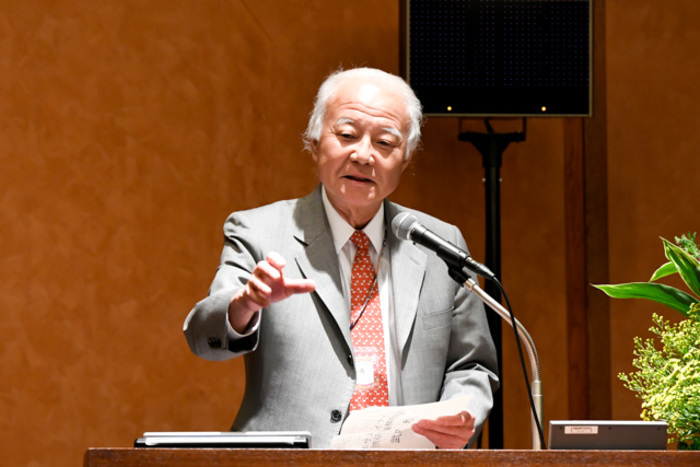Inaugural Symposium for Institute for Future Initiatives “Imaging a Sustainable Future: SDGs and the Future of Academic Research”
- Date:2019.03.08(Fri.)
- Time:16:00 - 18:00
- Venue:Ito Hall, Ito International Research Center B2F, the University of Tokyo
- Hosts:
Policy Alternatives Research Institute(PARI), Integrated Research System for Sustainability Science(IR3S)
- Language:
Japanese / English (Simultaneous interpretation will be provided.)
In April 2019, Policy Alternatives Research Institute and Integrated Research System for Sustainability Science will merge to form Institute for Future Initiatives, in order to advocate a vision that must be shared and realized for the future world. This meeting is held on the occasion of the inauguration of our new Institute.
The United Nations have proposed 17 goals for changing the world. The Sustainable Development Goals, or SDGs are now widely shared as a common vison, but we also observe policies that are focused in advancing national interests at the expense of global agenda. How, then, can we address common goals that reach beyond national borders? What are the roles of academic institutions in realizing SDGs? We wish to invite you all to consider these questions.
- 16:00-16:05Opening Remarks
Kiichi Fujiwara, Director, Policy Alternatives Research Institute(PARI)
- 16:05-16:20Keynote Speech
Makoto Gonogami, President, the University of Tokyo
- 16:20-17:30Panel Discussion
Panelists:
David M. Malone, Rector of the United Nations University, Under-Secretary-General of the United Nations
Naoko Ishii, CEO and Chairperson of the Global Environment Facility (GEF)
Hiroshi Komiyama, Charman of the Institute, Mitsubishi Research Institute, Inc.
Hideaki Shiroyama, Professor, Graduate School of Public Policy, the University of Tokyo
Facilitator:
Kiichi Fujiwara, Director, Policy Alternatives Research Institute(PARI)
- 17:30-17:55Q & A
- 17:55 ‒ 18:00Closing Remarks
Kazuhiko Takeuchi, Director, Integrated Research System for Sustainability Science(IR3S)
Symposium Overview
In April 2019, the Policy Alternatives Research Institute (PARI) and Integrated Research System for Sustainability Science (IR3S) will be combined to form the Institute for Future Initiatives (IFI). On the occasion of the inauguration of this new Institute, we held an international conference with the title “Imaging a Sustainable Future: SDGs and the Future of Academic Research.” While the UN has proposed a set of goals for creating a sustainable world in the form of SDGs, we nonetheless observe nations to enact policies biased toward protecting their own interests rather than responding to contemporary global issues. In light of this, we discussed how academic research organizations can address transnational issues.
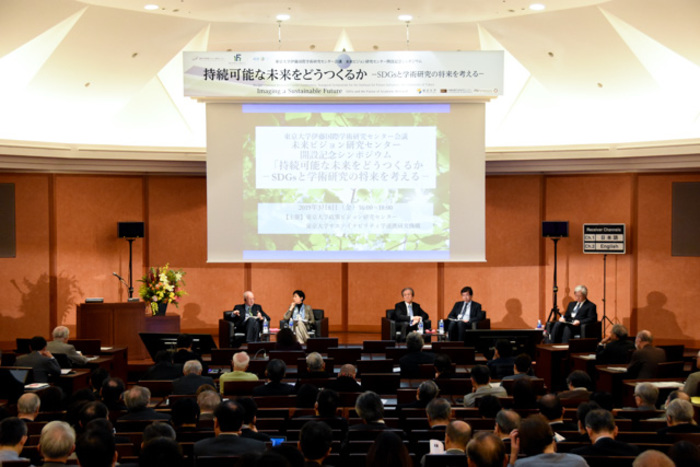
Opening Remarks Kiichi Fujiwara, Director, Policy Alternatives Research Institute
To commemorate the inauguration of the Institute for Future Initiatives (IFI) on April 1 this year, this symposium has been organized to create opportunities to learn together in various forms. As the title “Imaging a Sustainable Future” suggests, we are faced with various issues to respond to. However, just solving issues does not give us an image of what kind of future we are trying to create. Therefore, in the IFI, we will create an image of the future to be aimed at, and recapture the current options from there. In other words, we would like to create a direction of research in which we consider what we can do now in order to create the future. Also, university activities are not always clearly visible from the society. Therefore, as an organization that presents specific current options through university research, we would like to explore what role a university can play with various social collaborations. The IFI aims to become a hub of those collaborations.
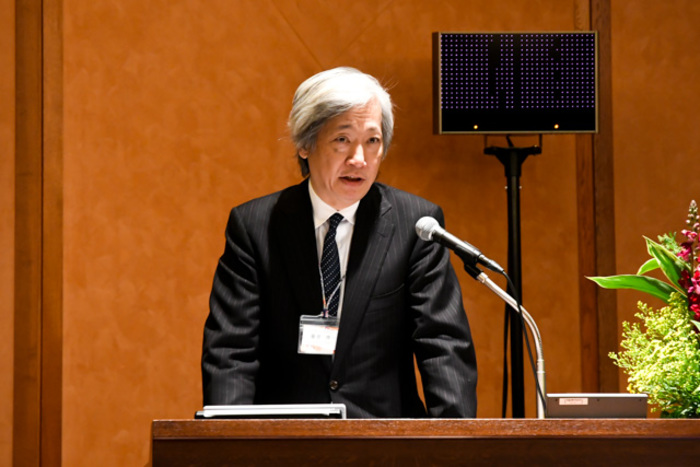
Keynote Speech Makoto Gonokami, President, the University of Tokyo
“Society 5.0” is a word to talk about an image of the future. In the 5th Science and Technology Basic Plan of the Cabinet Office, an image of the future society was presented where the digital revolution has taken on momentum and Society 5.0 appears as a new society to follow the hunting society (Society 1.0), the agrarian society (Society 2.0), the industrial society (Society 3.0), and the information society (Society 4.0). Society 5.0 is what was imagined as an inclusive society brought about by the digital revolution. A society in which everyone can participate is the concept that the United Nations has embraced in SDGs, and we are promoting discussions on how to embody Society 5.0 and what contribution Japan can make to SDGs.
At the Davos meeting of the World Economic Forum held in January this year, one of the topics was the limits of the earth. The economic development has so far been made by expansion, and has reached its limit. Considering inclusiveness, however, the current society is far from being an inclusive society, and there is great potential for growth in it. Therefore, the development of regulations to make good use of the digital revolution and utilize data and information that carry value has become an important issue right this time. Should we develop regulations first like the European General Data Protection Regulations (GDPR), or should we give priority to the widespread adoption of digital technology? Prime Minister Abe, who participated in the Davos meeting for the first time in five years, used the words “Data Free Flow with Trust,” and said that Japan will lead the development of data distribution rules. This is also a declaration that Japan will create basic rules in the international society of Society 5.0, and the University of Tokyo has also been deepening discussions about the rules and the strategy of Japan.
When knowledge and information, rather than things, have values, networks in the cyberspace through which data are carried become extremely important. In fact, universities utilize the ultra-high-speed academic information network (SINET), which connects 47 prefectures. It has been developed for research fields that distribute and analyze huge data, but if it is made available for other applications, it will become an infrastructure of the future with a great advantage. In this way, having a specific image is extremely important to create a better future together. In order to gain sympathy of the society, the University of Tokyo is now listing up future images as a university-wide project. We established the Future Society Initiative (FSI), and have had researches being conducted on campus associated with SDGs and registered. More than 180 projects have already been registered, and issues and participating departments are cross-sectoral.
One of the directions of IFI, which will be newly established under these circumstances, is inclusiveness. We will present our future vision of creating an inclusive society. Another is fundamental. We will pursue fundamental issues as academic study. The third is innovative. We will reform the industry, government, academia, and the public at one time and strengthen the platform function. In order to create a new society, it is necessary not only to create scientific innovations, but also to modify legal systems and to support economic mechanisms. While putting this three-pillar strategy in action, we also bring in the perspective of humanistic wisdom to consider what a better society is like in the first place. The IFI will certainly be launched as a working force.

Panel Discussion
Facilitator Kiichi Fujiwara, Director, Policy Alternatives Research Institute
The SDGs, which aim at a better future, list up various themes. All of them seem important, but it’s hard to see which one to aim at. Market issues exist, too, and depending on the situation, the economic recovery of your own country tends to be prioritized over long-term issue solving. In addition, sustainability is actually linked to issues such as conflicts and peace building. We have to discuss how to create a sustainable society, not only in Japan but also globally, across borders. Based on the current situation, the panel discussion will have three themes: What is the future to be realized, what are the obstacles to its realization, and what are the roles of academic research.
David M. Malone, Rector of the United Nations University / Under-Secretary-General of the United Nations
The SDGs have 17 goals. They are somewhat abstract and plentiful. Furthermore, there are as many as 169 targets, which make it a complex package. Some of the 17 goals are costly; for example, countermeasures against climate change, and their realization is premised on stable economy and continuing economic growth. They require economic growth in developing countries in particular. It is a new aspect the Millennium Development Goals (MDGs) did not have, which established goals to be achieved in the process of social maturation. While the MDGs were positioned as government-led initiatives, the SDGs require cooperation of companies, NPOs, and governments, as they have highly ambitious and costly targets.
One of the potential barriers to achieving these goals is the large number of targets: 169. You can grow skeptical and think that nothing will work out. If each country prioritizes and works on three or four goals, however, it is possible to achieve them. It is premised, though, that the economy is stable and there is no security crisis. Considering the 10-year economic cycle, it is not surprising to have a recession in the near future. There are also regions in the world that are in a serious security situation. Another issue is how to consider the amount of investment. Both the MDGs and the SDGs require us to invest a huge amount of money, but the burden is on the world as a whole, and it needs to be regarded as a task of the whole humanity.
In addition, higher education is more important than ever for securing human resources. Especially in developed countries, the role of universities is extremely important. Education is also the fourth goal of the SDGs. The competition in quality of higher education among countries is intensifying, and in some cases, companies play the role of universities. Is Japan successfully riding this trend? As far as research activities are concerned, industry-academia collaboration has worked well in research that has narrowed down the targets, which Japan is good at. However, we should look at areas that may be useful in the future, and need to expand our research areas.
Universities tend to be arrogant and become conceited easily. A notable issue in the United States is the high tuition and fees arising from the high self-esteem of the universities, which is increasingly criticized by students. This snobbery can lead to isolation. On the other hand, the grassroot civil society is very humble and will make a good partner for the universities to learn a lot from. The universities should not forget these things.
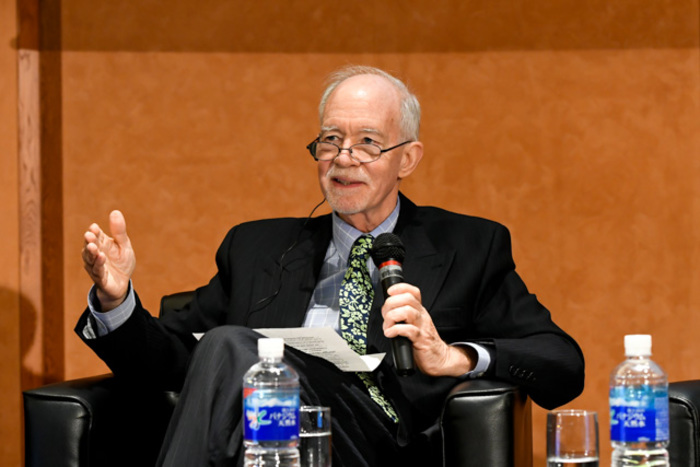
Naoko Ishii, CEO and Chairperson of the Global Environment Facility (GEF)
I would like to see two futures. The first is a sustainable earth. Recently, scientists are concerned that the current economic model will destroy the earth. Scientists such as Johan Rockström advocated the concept of Planetary Boundaries, and evaluated the status of nine subsystems of the earth that are important for human development, to find out that biodiversity and the circulation of chemicals are in a critical condition. As a result, scientists and economists have proposed a review on four economic systems. The first is a transformation of the energy system; a shift from fossil fuels to renewable energy. The second is a development of environmentally friendly and livable cities. And the third is the food production system. The deforestation resulting from the increase in food production and the chemical substances contained in fertilizer actually put a heavy load on the earth. The fourth and final is an economic model. In the current economic model of using and discarding, only 9% of collected mineral resources is recycled. In fact, I would like to emphasize that the future life with transformed economic systems is a very good thing, with livable cities, clean energy, healthy and safe food, etc.
The second future is realization of an inclusive society. With numerous global issues piling up, widening inequality has been one of the causes of growing dissatisfaction with politics and lack of social cohesion, characterized by the birth of the Trump administration in the United States and the activities of the Yellow Vests in France. The widening inequality hinders the mobility of society, but in an inclusive society, everyone can have hope in their lives and is able to maximize their potential.
All global environmental issues are those of global public goods, but there is no appropriate method to manage them. There are treaties between nations, but I feel that there is a limit to such arrangements when I think about the climate change treaty. Recently, multi-stakeholder coalitions have begun to draw attention as a new mechanism to manage global public goods. They have appeared in various fields such as energy and forest management, and are expected to become a new mechanism involving governments, companies, civil organizations, and academia.
There are two important roles of academic research institutes in solving global issues. One is academic research to establish paths to achieve future goals; conducting cross-sectoral research, promoting collaboration between science and policies, and interacting with society. The other is co-creation of global initiatives. The Paris Agreement, for example, was able to be agreed upon because there was a specific setting of the 2°C target. “Earth targets” that lead the society are also effective in biodiversity and water resources. It is expected that practical knowledge will be created through co-creation with stakeholders.
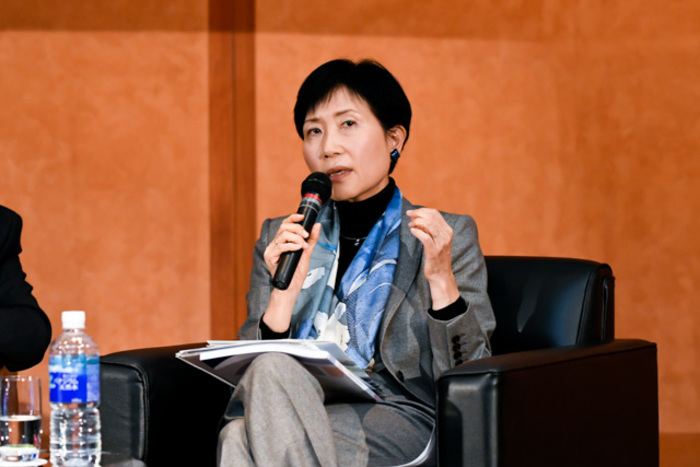
Hiroshi Komiyama, Chairman of the Institute, Mitsubishi Research Institute, Inc.
I have proposed a “platinum society” as the future society. Our generation is the first one in human history that has all of the following: goods, information, transportation, and longevity. And what people want next is self-realization. The platinum society is a society where the earth is sustainable and rich, and that enables self-realization. I think that there are bright elements for sustainability of the earth. The first is population and material saturation. It is predicted that the world’s population will saturate with about 9.6 billion people in the second half of this century and there will be no population explosion. As for materials, iron, for example, can be reused once made, so we will enter a time when it will need to be produced solely in urban mines and natural mines are no longer necessary. Another hope is renewable energy. With renewable energy you can already produce electricity more cheaply than with natural gas or coal. This is a world average, but in the near future Japan should be able to produce electricity with renewable energy as cheaply as they do. Considering that underground resources are mostly metals and fossils, 2050 will be in an era when underground resources are no longer necessary, and we will be able to plant trees once again on land that is wasted now.
For self-realization, freedom and diversity are important. For example, at Mayekawa Mfg. Co., Ltd., which has set no retirement age, they have been successful in creating new machines through collaboration between old veterans and younger employees. And now, as the handicap arising from regional differences is actually not so large and the office environments are not different, some companies have head offices and satellite offices in rural areas. There is also an initiative where college students and retired engineers get together and teach programming to children.
As described above, I feel that there is reasonable hope. However, Japan does not move, possibly due to lack of sense of urgency. I’m an engineer, so I would like an answer rather than knowing disincentives. And one answer is student activities you can find in COI. There are 18 “hyper-universities”, an example of which is the case of Hirosaki City, where the local community, hospitals, and universities including Hirosaki University collaborate with each other and handle the world’s largest health big data. I would like to call such a group, which is gathered at one site, a hyper-university. The initiative where students and researchers go to Tanegashima island, which has no university in it, and teach high school students is another example of a hyper-university, and students are the key players.
When young people participate with logic, the society changes. Just explaining with logic does not move the society. The importance of adding humanity to reasons is what I discovered from the hyper-universities. This is the very integration of arts and science. To integrate with others as necessary is the method science has taken so far, and this is in fact the social implementation. There is no other way to make academic development than pursuing issues of sustainability and future society while making social implementation, and I hope that they will continue to promote these initiatives.
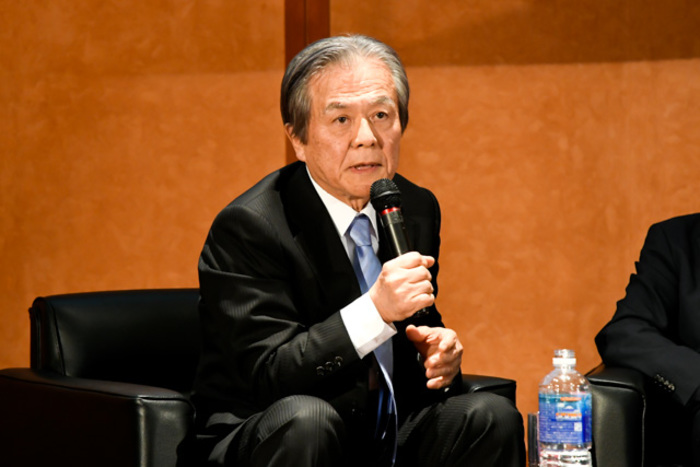
Hideaki Shiroyama, Professor, Graduate School of Public Policy, the University of Tokyo
As a humanist and social scientist, my role will be to talk about the contribution of humanistic wisdom. First, to respond to the question of what kind of future the social image implied by SDGs presents, I would like to start from the question of whether SDGs actually imply a social image. If you concentrate on the 17 goals of the SDGs individually, the goal settings for each field will only be taken over just as before. It is social image deliberation in a true sense to make value judgements, taking into account contradictions and trade-offs between the goals, and make choices as a society. The SDGs are just an entrance to it. In addition, the SDGs include not only energy related issues but also health related issues, and suggest unexpected connections. The coexistence of social purposes is prompted by the SDGs, and then value judgments are ultimately required to be made by each society and individual.
Does Society 5.0 also tell the image of the future society well enough? It is basically a methodology that combines cyber space and physical space to obtain richness and solve issues. Its explanation of inclusiveness, which states that “everyone can play an active part,” is also weak. I think it is important for the humanities to make contributions to such discussions in order to talk about what the future society should be like.
In the IFI, which will be inaugurated soon, it is necessary to consciously discuss how to talk about the future. Currently, in various contexts, they say evidence based policy making is necessary. It is a solid methodology, but to talk about the future, you will need not only a limited past, which has evidence, but also a variety of inputs. We need to find materials such as social experiments and simulations in the information and engineering domains, stakeholder analysis in the social science domain, cultural anthropological methods, and subjective information including design thinking. In addition, it is one of the important methods to have a future image in mind and backcast, but it is also important to imagine what will happen and prepare for it.
There are two points with regard to the distance between universities and the society. One is social implementation. You can participate not only in the creation of knowledge but also in the implementation of knowledge as a real actor. The other is to properly establish an agenda as to what the issues are. The role to formulate an agenda, which is enlightenment in the contemporary era, is also important for universities or academic research, if you cannot solve the issues of 2030 or 2050.
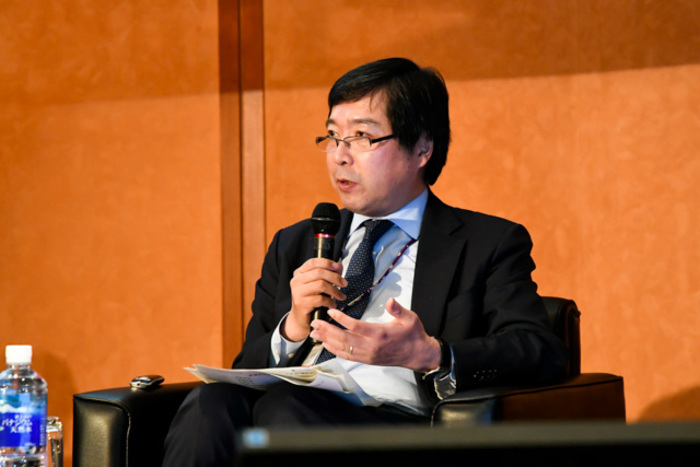
Q&A
Opinions were exchanged primarily on three issues:
Possibility of realizing a 100% renewable energy society
A question was raised whether a society that makes electricity 100% from renewable energy would incur a cost of adjusting unstable renewable energy and thus be rather expensive. In reply, the panelists said that given the high level of accuracy of technology predictions, illustrated by the fact that the prediction that the cost of solar power generation would be reduced to one-fifth in 10 years has been correct, the prediction will remain reliable. Based on that, they presented their view that considering a number of predictions of what can be made cheap with future technology, an energy structure 80% of which is accounted for by renewable energy can be realized without increasing costs. They also stated that in order to achieve a 100% renewable energy society, additional measures such as utilization of hydrogen would be necessary, and it may cost money, but it will still remain feasible.
How to think about development
SDGs’ D stands for development, but there was an opinion that we should curb further development and change them to SCGs that emphasize coexistence such as co-design and community. As for limits to growth, a claim was made when a report by the Club of Rome was published in 1972. With globalization, however, a tendency to put priority on economic growth and security of your own country became stronger, and the claim was abandoned once. There was a time when a strong claim was asserted that we should reconsider development in the face of excessive progress in industrialization, and also a time when there was a conflicting opinion that development is a right to escape from poverty. However, the meaning of the word development is large at present; realization of health, for example, is also regarded as development that has meaning to humans. On the other hand, it was also argued that the impact of economic progress and development on the environment needs to be monitored now and in the future.
Driving forces to move people and the society
There have been companies’ efforts to stimulate consumer’s emotions, and driving forces that move the society were discussed. As another example, it was mentioned that in recent years in Europe, a protest movement to boycott classes on Friday has been spreading among young people who have questioned the significance of education, and an opinion was offered that it is important to consider how to involve young people in order to move the society. Another view was also presented that when you live in the real world, you will also develop the ability to recognize deceptions, so just explaining the need for SDGs cannot move the society. It was pointed out that it is the role of universities to specifically propose what can be realized, and what can be realized at a reasonable cost and with merits.
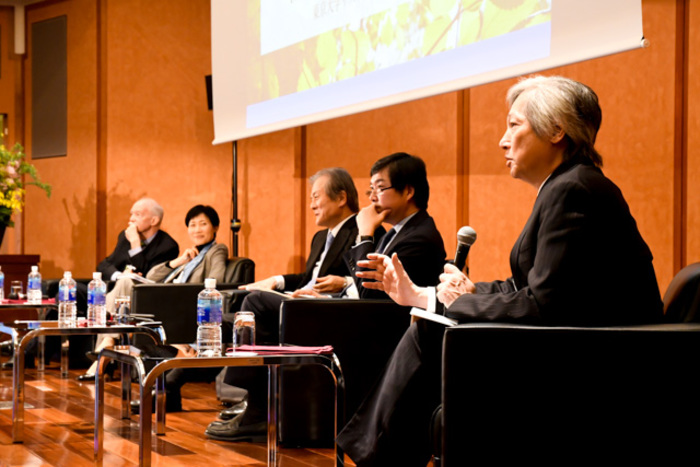
Closing Remarks Kazuhiko Takeuchi, Director, Integrated Research System for Sustainability Science (IR3S), the University of Tokyo
Five arguments have been presented at the symposium. The first is that the role of the newly established IFI will be to promote cross-sectoral integration of opinions, and it will be most important to direct the outcomes to social implementation. The second is the importance of multiple perspectives that capture both global and local issues. The third is the importance to collaborate with the society from the first stage. The importance of co-design and co-delivery had already been talked about often, but on top of that, co-innovation was emphasized in today’s discussions. The fourth is that the time has come for developed and developing countries to work together. In the past, the responsibilities held by each were considered to be different, but in the Paris Agreement, that wording was gone, and the time has finally come when developed and developing countries can discuss on the same ground. And the fifth and last is the importance of multi-stakeholder coalitions. In New York, meetings on SDGs are held regularly, and various people, such as companies, local governments, groups of women, and groups of young people, participate in discussions in their respective forms. We should seek multi-stakeholder involvement in our discussions as well.
